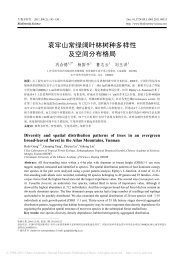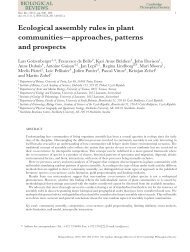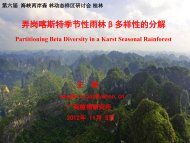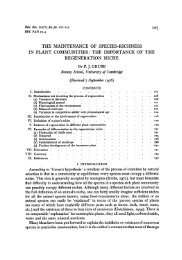Contents - ä¸å½æ£®æçç©å¤æ ·æ§çæµç½ç»
Contents - ä¸å½æ£®æçç©å¤æ ·æ§çæµç½ç»
Contents - ä¸å½æ£®æçç©å¤æ ·æ§çæµç½ç»
- No tags were found...
Create successful ePaper yourself
Turn your PDF publications into a flip-book with our unique Google optimized e-Paper software.
Tree Survival in a Chinese Temperate ForestFigure 3. Standardized parameter estimates (±2 SE) of abioticand biotic variables and size on tree survival for threeabundance classes in the Changbai temperate forest. Filledcircles indicate significant effects (P,0.05). Abund1, Abund2, Abund3and Abund4 show abundance classes with ,100, 100–1000, 1000–5000and .5000 individuals, respectively.doi:10.1371/journal.pone.0029469.g003complex models with biotic and abiotic predictors. In a study ofold-growth conifer forest in the USA, Das et al. [5] also found thatneighborhood variables, such as conspecific density, improvedmodels used to predict tree mortality. Our results were alsoconsistent with results from a tropical forest: Uriarte et al. [9] foundthat tree survival in a Puerto Rican forest was size-dependent, butalso susceptible to crowding effects of neighboring trees, specieslife-history traits and infrequent disturbances (e.g. hurricanes).Abiotic and biotic neighborhood effectsThe relative importance of abiotic and biotic factors on treesurvival and species coexistence in forest communities has been thesubject of a continuous debate, but researchers are now generallyconvinced that these mechanisms are not mutually exclusive [64].In the present study, we found that the relative importance ofabiotic factors on tree survival tended to be less than that of bioticfactors, at least in terms of the variables included in this study. Thisresult may be partially caused by the small spatial variation inabiotic factors in the CBS temperate forest. Topography withinthe CBS plot is relatively gentle with a maximum difference inelevation of less than 18 m in the 25 ha plot [65]. Therefore,abiotic environmental factors have low spatial heterogeneity,which may explain the relatively small effect of abiotic factors ontree survival. This result is consistent with a recent study ofseedling survival in a temperate forest in Japan [66], which foundthat significant effects of abiotic factors on seedling survival werelimited, while effects of biotic variables were more common.However, the best fit models at the community level and formany of the guilds and species examined tended also to includeabiotic factors, indicating that abiotic factors do contribute topatterns of tree mortality. Moreover, our study only includedtopographical and soil nutrient variables, and may have missedsome other important abiotic factors, such as light (althoughvariation in light levels will be captured in part by bioticneighborhood variables). It should also be emphasized that ourstudy is constrained to the plot level (i.e. 25 ha) and that abioticfactors were measured at the 565 m scale. At larger and smallerspatial scales, the relative importance of abiotic factors maychange.Among the biotic factors tested, total basal area of neighborstended to have a negative impact on survival, suggestingcompetition for resources occurring among trees of all speciesleads to thinning [67–68]. However, the frequency of conspecificneighbor basal area also tended to have a significant negativeeffect on tree survival, indicating that neighbors of the samespecies have stronger effects than neighbors of different species,likely due to strong intraspecific competition or natural enemyeffects. Although not explicitly addressed in the present study, anumber of studies have implicated pathogens as a major driver ofnegative conspecific effects in plant communities [22,69–70]. Ourresults are consistent with most previous studies in both tropical[9,23] and temperate forests [8,28,29] that have found negativeeffects of conspecific neighbors on tree performance. These studiestended to support the idea of negative density- and frequencydependenteffects. As a result, negative density- and frequencydependenceis widely hypothesized to play an important role inpopulation dynamics (e.g. recruitment, growth and survival) offorest trees, and these processes could further contribute to speciescoexistence in these communities.Variation among ecological guilds and speciesConsiderable differences occurred among ecological guilds inthe effects of different factors on tree survival in the CBStemperate forest. For shade-tolerance, we found that survival oflight-demanding species and mid-tolerant species were influencedby the biotic, but not the abiotic factors. In contrast, the survival ofshade-tolerant species was impacted by both biotic and abioticfactors. This may be because mid-tolerant species and lightdemandingspecies are more sensitive to shading, and thus theirpatterns of mortality are primarily driven by competition for light(i.e. the biotic neighborhood). In addition, these guilds may bemore sensitive to host-specific natural enemies [42], and thereforemay be more strongly influenced by their local biotic neighborhoods[71]. Among abundance classes, we found significant effectsof abiotic variables only for the common and very commongroups. This may reflect that more common species are morestrongly impacted by soils and/or topography than less commonspecies; however, because sample sizes were smaller for the lesscommon species groups, our power to detect significant effects ofneighborhood variables was reduced relative to analyses of themore common species groups. Previous studies in tropical forestshave found that less common species suffer stronger negativeeffects of conspecific neighbors [23,43]. However, our studyshowed that negative effects of conspecific neighbors werestrongest for the very common and very rare groups (althoughPLoS ONE | www.plosone.org 6 February 2012 | Volume 7 | Issue 2 | e2946958
















